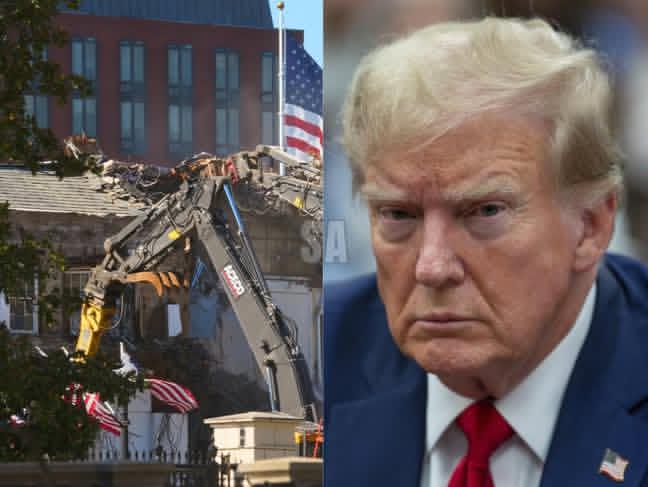CELEBRITY
JUST IN: A Detailed Look at the Millions in Private Investor Funds Given to Donald Trump for the White House East Wing Demolition — and Why ACECO Demolition Company Is Publicly Accusing Him of Failing to Pay What They’re Owed

Washington, D.C. — Newly uncovered financial documents and contractor statements have shed light on the tangled web of private investor money, unfulfilled promises, and spiraling legal disputes behind Donald Trump’s controversial attempt to demolish the White House East Wing for a luxury ballroom expansion project.
At the center of the storm is ACECO Demolition Company, a major contractor that worked on the project before the Supreme Court issued an emergency injunction halting all ongoing demolition.
The company is now publicly accusing the former president of failing to pay millions in outstanding invoices — despite revelations that Trump received substantial private investor funding specifically earmarked for the project.
The Private Investor Money: Where It Came From
According to leaked briefings, internal memos, and financial disclosures obtained by multiple media outlets, Trump secured more than $48 million in private investor contributions over the past year to finance the demolition and reconstruction of the East Wing.
These funds reportedly came from:
Ultra-wealthy political donors who wanted exclusive access to a new “Presidential Grand Ballroom”
Foreign business partners who viewed the project as a route to improved relations with a future Trump administration
Real estate investors hoping to tie themselves to a high-profile renovation of the most famous residence in the world
Sources familiar with the fundraising effort confirm that Trump promised investors naming rights, preferred event access, and private use of the ballroom once completed — arrangements that legal experts say are explicitly prohibited under federal ethics and historic preservation statutes.
Why ACECO Says They Haven’t Been Paid
In a rare and unusually direct statement, ACECO Demolition Company broke weeks of silence on Friday, accusing Trump and his transition finance team of refusing to pay approximately $3.1 million owed for labor, equipment, hazardous-material removal, and emergency structural stabilization performed during the first stages of the East Wing teardown.
ACECO spokesperson Daniel Weiss said:
> “We fulfilled every contractual obligation asked of us. The Trump team has not fulfilled theirs. Our company does not work for free, and we will pursue every legal avenue available.”
According to ACECO, the unpaid invoices date back more than eight weeks — and were submitted before the Supreme Court halted the project. Emails show repeated attempts from the company to reach Trump’s legal and finance advisers, all of which went unanswered.
If Trump Had $48 Million, Where Did the Money Go?
That question is now at the heart of growing congressional and federal inquiries.
Investigators are examining whether:
Investor funds were diverted to unrelated Trump business debts
Money was used for personal expenses or campaign-adjacent activities
The project was intentionally underfunded to shift future costs onto taxpayers
Contractors were misled about the availability of funds
One Senate staffer described the financial trail as “a maze built to be confusing.”
The Legal Picture: Trump Faces Multiple Fronts
The financial dispute with ACECO comes on top of:
The Supreme Court’s emergency injunction halting all demolition
A $10 billion lawsuit by the National Trust for Historic Preservation alleging environmental and heritage law violations
A rapidly expanding financial audit of private investors involved in the ballroom project
Investigations into whether Trump used improper influence or false claims to secure investor funding
Legal experts say ACECO’s decision to go public significantly worsens Trump’s position.
“Contractors rarely speak out unless they believe they’ve been deceived,” said legal analyst Marsha Langford. “If ACECO can prove the Trump team had funds available and simply did not pay, that opens the door to fraud allegations.”
Trump’s Team Issues a Defensive Response
A spokesperson for Trump dismissed ACECO’s public complaint as “politically motivated theater.”
They claimed Trump fully intends to pay “valid invoices” but accused the company of:
Inflating costs
Charging for unauthorized work
Misrepresenting their agreements
ACECO immediately refuted those assertions, releasing partial contract excerpts showing pre-approved rates, government clearance documents, and detailed work logs from the demolition site.
Growing Public Questions
With investor agreements, contractor disputes, and legal battles all colliding, public scrutiny of the East Wing project — once dismissed by critics as an extravagant vanity project — has intensified dramatically.
A coalition of preservation groups has demanded a full federal investigation into all investor involvement, warning that the project may have violated:
The Antiquities Act
The Historic Preservation Act
Federal conflict-of-interest laws
Multiple environmental protection statutes
What Happens Next
Congressional committees are preparing subpoenas. ACECO is preparing to file a lawsuit. Investors are reportedly demanding answers. And the partially demolished East Wing remains frozen in legal limbo.
As political pressure mounts and financial inconsistencies come to light, one truth is becoming increasingly clear:
The ballroom project intended to elevate Trump’s legacy may instead become one of the most legally damaging episodes of his political career.













